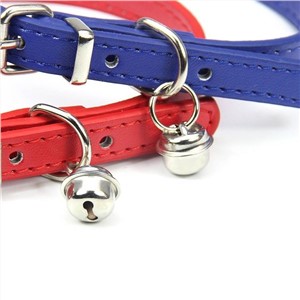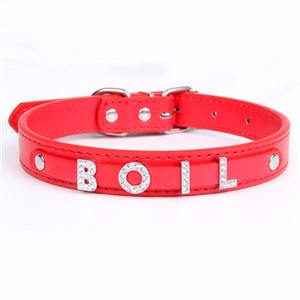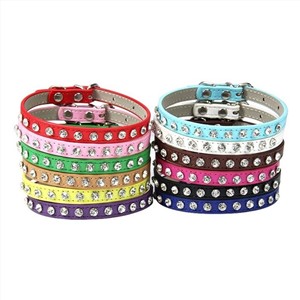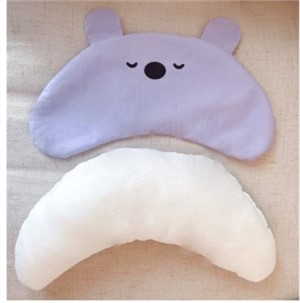Company advantages
Our certificate
Bonzer Pet quality management system has been certified by ISO9001:2000 and ISO9001:2008 as well as the national military standard GJB9001-2001A.
Competitive Price
We offering a higher-quality product or service at an equivalent price. As a result we have a growing and loyal customer base.
Customized Services
We understand that each customer has unique manufacturing needs. That's why we offer customization options to cater to your specific requirements.
24h Online Service
We try and respond to all concerns within 24 hours and our teams are always at your disposal in case of any emergencies.across borders.
What is Pet Collar
A pet collar is a device worn around the neck of an animal, primarily cats and dogs, for identification and control purposes.Pet collars play a very important role in pet life. A Pet collar is a piece of material put around the neck of a dog. A collar may be used for restraint, identification, fashion, protection, or training (although some aversive training collars are illegal in many countries). Identification tags and medical information are often placed on dog collars.
Benefits of Pet Collar
Identification
Collars often feature tags with the pet's name, owner's contact information, and sometimes medical information. This helps in reuniting a lost pet with its owner and can be crucial in emergency situations.
Control
A collar is typically used in conjunction with a leash to control and guide the animal during walks or when necessary to restrain the pet in public places.
Safety
Reflective collars improve visibility at night, helping to prevent accidents. Breakaway collars are designed to release if the pet gets caught on something, reducing the risk of injury.
Medical Alert
Certain collars may include medical alert information, such as indicating that a pet is deaf or has special health conditions requiring attention.
Training
Collars can be used in training, with different types such as flat collars, martingale collars, or choke collars serving various purposes in obedience training and behavior modification.
Fashion
Collars come in a wide variety of styles, materials, and designs, allowing pet owners to express their personal taste and match their pet's appearance.
Flea and Tick Control
Some collars contain insecticides that repel or kill fleas and ticks, providing a measure of protection against these pests.
Types of Pet Collar
Choke Collars
This type of training collar will get the attention of your dog. The metal links will tighten when your pup attempts to pull on the leash. It creates an uncomfortable feeling that will cause your furry friend to stop what they're doing.Choke collars aren't ideal for fragile-necked or small dog breeds. They could cause more harm than good. Always ensure you're using the collar properly and that the collar is comfortable for your pup.
Choke Collar Tip
To place the collar on correctly, position the collar so that it looks like a “P.” This tip ensures the chain's pressure will release.
Slip Collar
The slip collar is a gentler training collar. It will tighten around your dog's neck if they pull, but it won't choke them. Place this collar high on your dog's neck, right below their ears. This specific placement helps guide your furry friend in a natural position, making them less likely to pull during walks. It's a great option for every dog owner because it's gentle and effective.
Buckle Collar
The buckle collar is popular for many dog owners but probably the most useless. Yes, it can provide many sizes, but it won't give proper feedback to your pup. It's more appropriate for smaller dogs than larger pups due to a lack of control.
Prong Collar
The prong collar works similarly to the choke collar by applying pressure to your dog's neck when they pull. The uncomfortable feeling will discourage your furry friend from pulling, and they'll become more responsive to you.The prongs should correct improper behavior, such as lunging, jumping, and pulling. Avoid using this training collar with small dogs and dogs who have sensitive necks. It can harm them.
Head Halter
This training collar has a design that's gentle on a dog's neck. It looks like a horse's bridle without the reigns. A head halter is the perfect training collar for pups that enjoy pulling but have sensitive necks. It doesn't apply the same pressure as a choke or prong collar.
Components of Pet Collar
Buckle
A buckle secures the collar around the pet's neck. It is generally made of metal or plastic and may have a quick-release mechanism for safety.
D-Ring
This ring is attached to the collar and provides a strong point for attaching a leash. It is typically made of metal and is designed to resist breaking under tension.
Adjustment Mechanism
Most collars have a method for adjusting the size to ensure a proper fit. This can be a series of holes and a buckle, a sliding clasp, or a plastic slide.
Inner Lining
Some collars have a soft inner lining made of fleece, neoprene, or other cushioning materials to increase comfort and prevent irritation to the pet's skin.
ID Tag Holder
An area or loop where an ID tag can be attached. The ID tag usually contains the pet's name and owner's contact information.
Reflective Material
Many collars are treated with reflective material to make pets visible in the dark, enhancing safety during evening walks or when outdoors at night.
Safety Features
Some collars include breakaway mechanisms that release the collar if the pet gets snagged on something, or they might feature a bell to help locate the pet or warn of its presence.
Pet Collar Features
Convenience
If you choose to go with a personalized collar for your dog, you won't have to worry about attaching a separate ID tag to your dog's collar, which can be bulky, noisy and just more complicated. Instead, all of your dog's identification information will be conveniently located on their collar.
Durability
Pet Collar from are made from the most durable waterproof, leather or synthetic webbing with high quality field tested hardware designed to withstand wear and tear from the rowdiest of dogs, which means that they will last longer than generic collars and tags. This can save you money in the long run, as you won't have to replace your dog's collar as often and most importantly this ensures your dog will always have readable identification. And did we mention that all of our embroidery and laser engraving is guaranteed for the life of your pet? Yep!
Customizable
They can be customized to fit your dog's specific needs and preferences. You can choose from a variety of materials, sizes, and colors, and include information such as your dog's name, phone number, and medical information.
More Style Options
They can also be a stylish accessory for your dog. You can choose from a variety of designs and materials that reflect your dog's personality, and coordinate with their outfit or other accessories.
Bonding
They can help strengthen the bond between you and your dog. By selecting a collar that reflects your dog's unique personality and preferences, you show them that you care about their individuality and that they're an important member of your family.
Emotional support
For dogs who provide emotional support to their owners, a collar with personalization can be a source of comfort and .
How to Choose Pet Collar
Safety protection
Pet collars are one of the important tools for protecting pet safety. Ensure that your pet wears a collar to make it easier for people to identify them and help retrieve missing pets in emergency situations. To maximize safety, pet collar cat is recommended that you use a collar with adjustable size and safety buckle.
Identification
Equip your pet with a tag that bears their name and your contact information, which can provide assistance in case the pet gets lost. In addition, you can also include medical information about your pet, such as allergies or diseases that require special care, so that others can provide correct assistance in emergency situations. The label should be made of durable and waterproof materials to ensure clear visibility in various environments.
Comfort and appropriate size
When choosing a pet collar, please make sure to choose a style with good comfort and appropriate size. A pet collar set that is too tight may cause suffocation or discomfort, while a collar that is too loose may make it easy for the pet to fall off. Measure the neck size of your pet and choose the appropriate pet collar based on your pet breed and size.
Material selection
The material of the pet collar hardware is also an important consideration. Soft, durable, and easy to clean materials can provide your pet with the best user experience. Common pet collar materials include nylon, leather, and metal chains. Please choose the appropriate material based on your pet's activity level and preferences.
Replaceability
Consider choosing replaceable collar accessories, such as replaceable labels or decorations, to increase the diversity of pet collars. This way, you can change different decorations for your pet at any time according to the season, festival, or personal preferences.
How to Maintain Pet Collar
Regular Cleaning
Wipe down the collar with a damp cloth to remove dirt, hair, and debris. For leather collars, use a leather cleaner and conditioner to keep the material supple. For fabric collars, machine wash according to the manufacturer's instructions.
Inspection for Damage
Check the collar regularly for signs of wear and tear, such as fraying, weakened stitching, or broken hardware. Replace the collar if any significant damage is found to prevent it from snapping or coming apart while in use.
Proper Storage
When not in use, store the collar in a cool, dry place away from direct sunlight. Avoid leaving it in a hot car or a damp basement, as extreme temperatures and humidity can damage the material.
Adjustment Check
Ensure the collar fits properly—not too tight (it should allow two fingers between the collar and the pet's neck) and not too loose (it should not slip over the head or off the ears). Adjust as needed, especially as the pet grows or loses weight.
Replace Buckles and Hardware
If the buckle or D-ring becomes loose or damaged, replace them to maintain the collar's integrity and safety.
Check ID Tags
Regularly check the ID tag to ensure it is legible and up-to-date. Replace tags that are worn out or have faded writing.
Protect Electronics
If the collar has GPS or activity tracking features, protect the electronic components from water damage and follow the manufacturer's guidelines for charging and care.
Use Correct Leash Attachment
Always attach the leash to the designated D-ring. Using another part of the collar can lead to uneven wear and potential failure.
5 Important Tips on How to Clean a Pet Collar
Use a gentle dog shampoo or soap to clean your dog collar
You can take your normal dog shampoo and just add some to a bowl of hot water. Put your dog collar in the bowl and if it's really dirty, you may want to give it a bit of rub to get any ground dirt out. Then leave the dog collar in the bowl for 15 to 20 minutes and then rinse clean. Then leave to dry after squeezing out any excess water.
Use a brush on synthetic dog collars
If your dog is really dirty you can take a stiff brush and use it to rub the dirt off, this is only applicable on synthetic collars (nylon webbing collars, in particular), and wouldn't be suitable for leather collars. You can repeat the cleaning cycle above using dog shampoo or gentle soap.
Use a damp cloth on leather collars
Leather dog collars are less water friendly and so more care is required. When it comes to leather and washing your dog's collar, using a damp cloth and very light soapy water should get rid of any residue. Ideally you don't want to get the leather too wet as it will damage and worse still could weaken.
Use baking soda
Adding a couple of teaspoons of baking soda to warm water (in a bowl) can be a good alternative to soap or shampoo. Wait until all the baking soda has dissolved, and then add your dog's collar. Let it soak for around 15 minutes and then use a brush to clean (if a synthetic collar). You can repeat until you are comfortable the collar is completely clean and odour free.
Use a washing machine
Check your dog collar label or brand instructions first to see if it is machine washable. Most collars are not machine washable, and doing so can cause irreparable damage. If your dog collar is machine washable then we would suggest you put the collar in a washing bag, a sock, or pillow case, or Ikea do good little laundry bags. This is so that any metal work is protected and doesn't make a lot of noise banging around in the machine.
Our factory
BONZERPET Was established in 2017. Our company is located in Hangzhou, two hours' drive from Shanghai and Ningbo port. Since then, We always specialize in producing all kinds of pet products. And we have achieved a rapid growth in pet business now.Our main products are included pet bed, pet clothes, pet toys and cat tree in our own factory. Now we have over 100 workers and 6000 square meters area. The production capability reaches 50pcs 40ft containers per month. On another way, we also do trade business of all kinds of other pet products. They are included pet collar & leashes, pet brushes, pet feeders, cat toys, small animal accessories, bird and fish accessories.
FAQ
What is the purpose of pet collars?
A dog collar is a piece of material put around the neck of a dog. A collar may be used for restraint, identification, fashion, protection, or training (although some aversive training collars are illegal in many countries). Identification tags and medical information are often placed on dog collars.Sometimes it's more than just wanting to prevent distraction-a “do not pet” dog collar could potentially prevent a bad injury. Dogs that are aggressive or who bite or snap at strangers could injure someone who enters their space.
Should pets have collars?
Accidents can happen when you least expect it and it's best to be prepared. Just as a smoke alarm is a safety device to protect you and your family, a collar and ID tag is a safety device to protect your pet.Collars can cause back pain or damage a dog's throat, especially if the dog tends to pull a lot while walking. Your veterinarian may advise you to avoid certain types of collars altogether. For example, choke collars and prong collars can seriously damage a dog's neck.
Do pet collars work?
Dog flea collars can be useful as a preventative tool in the fight against fleas and ticks. However, they're not appropriate for every pet in every situation. There are times when flea and tick collars for dogs can be a very valuable tool, especially for pets spending most of their time outdoors.
Do pets hate collars?
Not all dogs like wearing a collar. Maybe they've never worn one, they have a negative association with the collar, or they might even have some level of discomfort based on the collar material. Some dogs might tolerate wearing a collar but react nervously to being led by the collar or having their collar touched.
Should dogs wear a collar all day?
Choke collars, harnesses, and electric collars can be incredibly uncomfortable for your dog to wear all day. It could also irritate your pup's skin and damage its fur. There is no significant issue if you feel comfortable allowing your dog to sleep without their collar at night.
Do dogs feel better without a collar?
If your dog has long hair, removing their collar daily can help prevent matting where the collar lies. The same goes for short-haired dogs and their skin. The break from the collar gives their skin time to breathe and prevents rashes, irritation, or unwanted odors in that area.
Should dogs wear collars at home?
While a dog collar is essential for keeping your pup safe in the outside world, when you return to the comfort of your own home it's safer to remove your pet's collar.Generally, 3-4 months. For smaller dogs and cats, you can go for up to 4 months. For larger and giant dogs, 3 months.
How do dogs feel about collars?
Additionally, some dogs may view their collars as a personal space boundary, helping them to feel more secure and in control. However, not all dogs enjoy wearing collars. Some may find them uncomfortable or restrictive, while others may simply not like the sensation of having something around their neck.
Is it OK to put a collar on my cat?
Should cats wear collars? Generally speaking we wouldn't recommend putting a collar on your cat. If you're worried about them getting lost, the best way of making sure you're reunited is to get your cat microchipped. Collars can easily come off or get lost, but a microchip will always be there to identify your cat.
What do pets think of collars?
It can be uncomfortable and itchy, especially if worn for a long time. So, when the collar comes off, some dogs might scratch or rub their necks, feeling physically better. Dogs also recognize their scent on the collar. Some dogs may lick it to show it's theirs after the collar is off.Harnesses are usually the best choice for walking dogs because they don't put pressure on the neck. But collars are generally more comfortable and have a place to hold an ID tag. You should use a harness and not a collar if you have a dog prone to breathing issues (like a pug).
Do vets recommend e collars?
Common misconceptions and questions surrounding shock collars. STATEMENT: Do you think that I should use a shock collar to train my dog? ANSWER: No. We don't recommend the use of shock collars.s a bark collar a good idea? Generally, dog behavior experts recommend against them, especially because they're not a good replacement for training. With that in mind, here are some handy tips for working on your dog's barking… without using a bark collar.
Are collars annoying for dogs?
Not every pup loves wearing a collar. They can feel restrictive or irritating to a dog. You may find your dog is constantly pawing at it or trying to tear it off.Negative Association: Your dog may have had a negative experience related to the collar, such as it getting caught on something, causing discomfort, or being put on too tightly. These experiences can lead to fear or anxiety associated with the collar.
Why does my dog get mad when I touch his collar?
Resource guarding is a natural behavior that dogs exhibit to protect things they perceive as valuable, such as food, toys, or even their humans. If a dog perceives someone touching their collar as a threat to their possession, they may become aggressive or defensive.
At what age should a dog wear a collar?
You can put a collar and leash on your puppy as soon as you get your puppy, and you can take him or her for walks now too. This should go without saying that the walk you take a young puppy on is not the walk you take an adult dog on.This is the time frame in which a puppy is sensitive to socialization and can develop good habits and, hopefully, avoid problem behavior in the future. So how early is that? A week after your puppy's first round of vaccinations, which happens around 7-8 weeks.
Why should I take my dog's collar off at night?
In general, to protect your pup's neck, Hodges recommends rotating between a few different collars and regularly checking that they still fit well. She also recommends letting your dog sleep at night without a collar to give your pet's skin a chance to air out.
Do dogs get upset when you take their collar off?
In addition, taking off a dog's collar can also trigger underlying responses related to aggression or even fear in some canines. Dogs may think they're being punished or removed from their owner's pack if the collar comes off suddenly, so they may display signs of distress.The evidence is clear that calming collars may work for some dogs. But both the reviews and expert opinions make it clear they're not a guaranteed win for all or even most pups.
Should dogs wear collars 24 7?
Not only this but it can also lead to Skin problems down the road if worn 24/7. Dog collars when worn in abundance can break and rub off the hair and coat around the neck exposing the skin. This is a common occurrence and can lead to skin problems due to the harshness of the collars material and the constant rubbing.
Should I walk my dog with a collar?
If a dog pulls on their leash, a collar can damage the neck, throat and airway, spine and back. Therefore, a collar is unsafe for dogs with spine or back issues, neck issues, tracheal collapse, glaucoma, eye proptosis, or for any toy or brachycephalic breeds, such as Chihuahuas, Pugs or Bulldogs.
Can dog collars get wet?
A waterproof dog collar is not only better for your dog's comfort, but it can also benefit you too. When a regular collar gets wet, it stays wet long after your dog has dried. Not only is this unsanitary, but it can also cause long-term irritation around your dog's neck.Dogs are ok wearing a collar all the time. Just like you wearing a ring or a watch. But some dogs get over attached to their collar and get collar anxiety if it's taken off.
Can pet safe collars get wet?
With 5 levels of static correction and a tone-only mode, your pet will remain safe and secure in their designated play space. The waterproof design of this collar allows your dog to wear it rain or shine. Use this collar for dogs that weigh 5 pounds or more and who have a neck size between 6-28 inches.

New Year ins wind pet collar cute dog cat neck ring and wind DIY Christmas cat dog bell ring neck ring
Read More
Pet collar PU leather lead rope cat choker neck collar diamond alphabet necklace dog head cover Christmas ornaments
Read More
Large pets Christmas cat collars dog collars cat leash Leather Diamond bib ornaments wholesale
Read More
Cross-border new dog pillow cartoon bear dog kennial cat protection cervical spine removable wash chin pad Hypnotic pet pillow
Read More